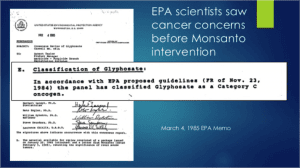Carey Gillam is an investigative journalist and award-winning author who spent 17 years on the food and agriculture beat for Reuters. Gillam is now research director of the public interest research group U.S. Right to Know. These remarks were delivered Oct. 11, 2017 before a joint public hearing on “The Monsanto Papers and Glyphosate” before the European Parliament committees on the Environment, Public Health and Food Safety; and Agriculture and Rural Development.
Links: slides via SlideShare; Carey’s remarks; video of Carey’s presentation and full hearing
usrtk.org/wp-content/uploads/2017/10/Carey-Gillam-Monsanto.mp4
Decades of Deceit: How Corporate Influence Has Manipulated Science and Safety Assessments on Glyphosate
Revelations from the Monsanto Papers and Other Research
 Good morning -I am an investigative journalist, someone who has spent 30 years focusing on facts, pursuing truth. And having spent roughly 20 of those 30 years delving into the dealings of Monsanto I can confidently tell you that the story of the company’s top selling chemical, glyphosate, is not one of truth, but one of deceit – carefully calculated and choreographed deceit. There is overwhelming evidence of attempts to deceive, and to do so in ways that manipulate the press and manipulate policy makers like you.
Good morning -I am an investigative journalist, someone who has spent 30 years focusing on facts, pursuing truth. And having spent roughly 20 of those 30 years delving into the dealings of Monsanto I can confidently tell you that the story of the company’s top selling chemical, glyphosate, is not one of truth, but one of deceit – carefully calculated and choreographed deceit. There is overwhelming evidence of attempts to deceive, and to do so in ways that manipulate the press and manipulate policy makers like you.
In my reporting role I – along with colleagues at U.S. Right to Know – have obtained thousands of documents from our US regulators as well as from US scientists who work at public universities, and these documents show clearly the long history of deception when it comes to presentation of glyphosate matters. In addition to those documents, we have now the thousands of pages of internal Monsanto emails, memos and other documents that make it clear beyond any doubt the efforts by this company to manipulate policy makers and members of the public.
You just heard panelists talk about the science. I’m here to share with you what the documents show about deception.We know from the documents that Monsanto has:
- Ghostwritten research papers that assert glyphosate safety for publication & regulatory review
- Provided alternative assessments for studies that Indicate harm; convinced regulators to discount evidence of safety problems
- Developed a network of European & U.S. scientists to push glyphosate safety message to regulators and lawmakers while appearing to be independent of industry
- Utilized public relations teams to ghostwrite articles and blogs that are posted using names of scientists who appear to be independent
- Formed front groups that work to discredit journalists and scientists who publicize safety concerns
- Provided EPA “talking points” to use if questioned by press about IARC classification
- Successfully pushed EPA to remove top independent epidemiologist from EPA Scientific Advisory Panel
- Enlisted 3 EPA officials to block a 2015 Glyphosate Review by the U.S. Agency for Toxic Substances and Disease Registry that Monsanto said would likely agree with IARC
Full text of remarks posted here (PDF). For many examples of Monsanto’s manipulations revealed inthe documents, see Carey’s slides posted below – slides also available via PDF or SlideShare.
[slideshare id=80870216&doc=careygillamslidestoeuropeanparliamenthearingonmonsantopapers-171016190325]
Link to video of Carey Gillam’s presentation and video of full hearing
Carey Gillam is a veteran journalist, researcher, and writer with more than 25 years of experience covering corporate America, and aformer senior correspondent for Reuters’ international news service.Her new book “Whitewash: The Story of a Weed Killer, Cancer and the Corruption of Science” was just released by Island Press. Carey is the former research director of U.S. Right to Know, a nonprofit organization that investigates the risks associated with the corporate food system, and the food industry’s practices and influence on public policy.









